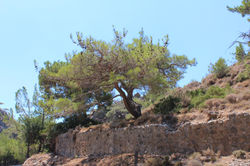
Aqueduct
of Syia
Ancient Aqueduct of Syia
Syia was the seaport city of Elyros. Its location has been identified at the modern settlement of Sougia. Architectural remains dated back in the Roman and Early Christian period (1st Century BC – 6th century AD) are preserved east of the bank of Sougianos or Kamarianos river, as well as on the foot of the eastern mountainous area.
One of the most important preserved architectural monuments is the aqueduct that supplied the city with water, which was channeled from a source located at St. Paul, north of ancient Elyros. Relics of the aqueduct are visible along the provincial road that leads to Sougia. The first remnants are traced at a distance of 3.2km away from Syia, close to the village Moni.
The known part of the aqueduct so fat consists of a masonry channel build in the upper part of a stone wall 1.5 – 2.0m high. The inner sides of the channel are covered with hydraulic mortar and the upper side with stones and mortar. The total length of the water – pipe is calculated at around 8km and its ability of daily water supply is estimated at 490 cubic meters, which today would sustain a 2500-resident town.
 Ancient Aqueduct of Sougia |  Ancient Aqueduct of Sougia |  Ancient Aqueduct of Sougia |
|---|
The course of the water – pipe maintained a stable gradient following the lie of the land. In the areas where the water – pipe crossed steams, there were constructed water – bridges, ruins of which have been identified at fout sites.
During the construction of the provincial road the aqueduct was cut vertically and its continuity is found on the east bank of the river. In this site the channel’s wall reaches 5.0m in height, in order to maintain the gradient.
Till now no traces of the aqueduct’s recipient or water distribution structures have been found. In the archaeological site are scattered cisterns that would supply with water private houses and thermae – public baths.
Source: Ministry of Culture and Sports